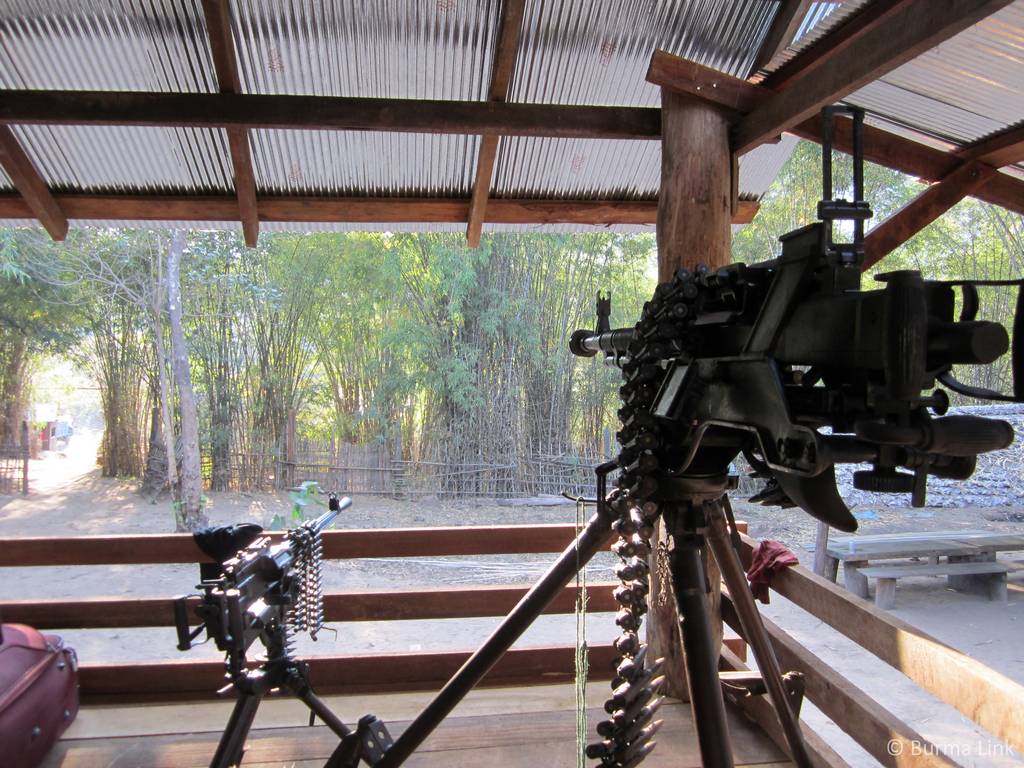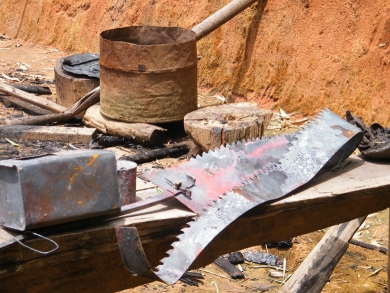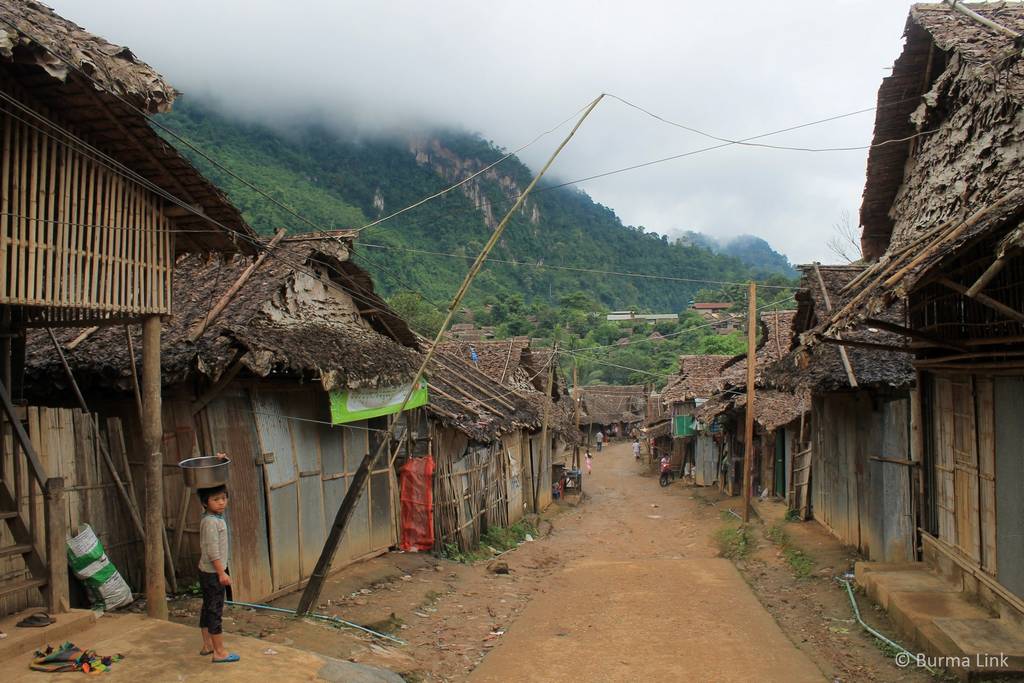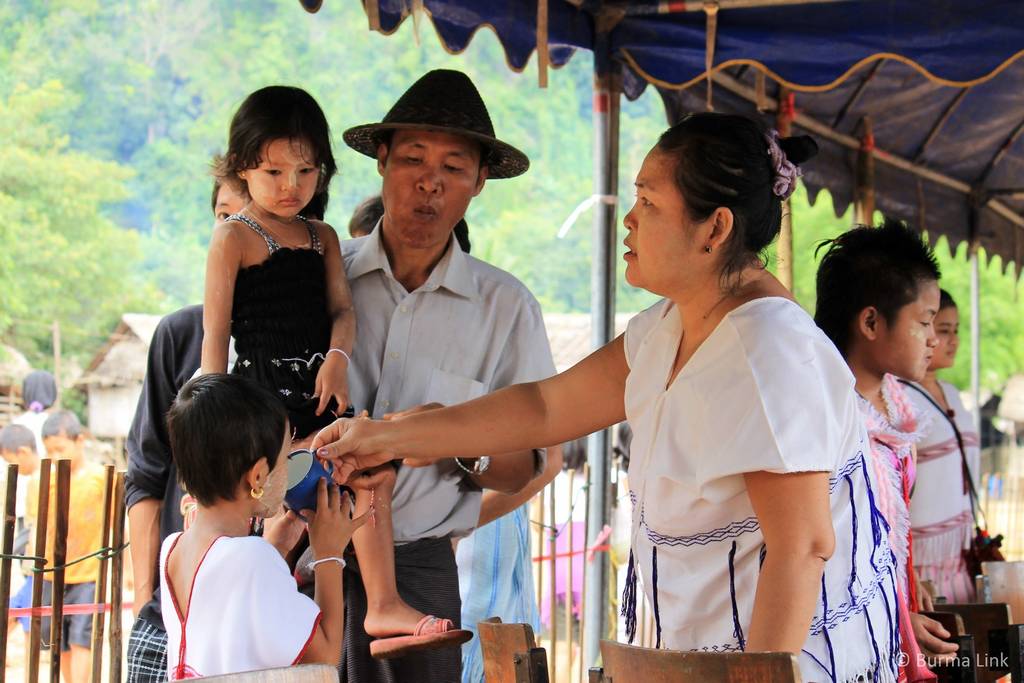In the following, a short history will be given to the ethnic conflict and the myriad ethnic non-state armed groups in Burma (for more information on specific ethnic nationalities and their histories, refer to Ethnic Groups). Sources have been omitted with regards to general information on history. Refer to sources for history of conflict at the end of the document.
The British policy of divide and rule had far-reaching consequences for the relationship between the Burman majority and ethnic minorities. The building of two separate systems of administration, Burma Proper dominated by the Burman majority, and Frontier Areas dominated by ethnic nationality groups, exacerbated existing differences between the Burman and other ethnic groups and set the different groups to very different roads towards development. Many ethnic groups celebrated the changes brought by the British, had close ties with them, and some even felt that the British liberated them from the Burman rule. Christian converts in particular, mainly belonging to ethnic nationality groups, often had close relationships with the British. Many Burman Buddhists resented the converts for joining with the foreign occupiers, resulting in religious persecution of Christians. As a consequence, many Christians turned to the British for protection, eventually taking their side in the Anglo-Burmese wars as well as in WWII. Many Christians are still persecuted for their religion in Burma today.
With the British by their side, many ethnic leaders at the dawn of independence believed that they had strong claims for self-determination. Many of them were unwilling to negotiate any conditions under which they would join the Union of Burma. As a consequence, many ethnic groups were not represented at the historic Panglong Conference that was organised in February 1947, where leaders from different groups met to discuss some important principals for the new Constitution. Of the main ethnic nationality groups, only Kachin, Shan, and Chin leaders attended the Conference while Karen leaders attended as observers only.
The Constitution that was adopted in September 1947 was drawn in a hurry because the Constituent Assembly was worried that the British would change their minds about Burma’s independence. While many ethnic leaders were not satisfied with the Constitution, they were told that it could be changed later on. The 1947 Constitution ended up riddled with anomalies on ethnic rights; the Shan, Kachin, and Karenni were awarded the voluntary right of secession after a 10-year period while the Karen, Mon, and Arakanese ended up having no state of their own. The Karen were promised an area but it was not decided where or how large it would be. Although some British leaders had promised to stand by the ethnic leaders, they soon reneged on these promises. In the aftermath of WWII the British had too many problems of their own and in the end decided to take no action on behalf of Burma’s ethnic nationalities. Feeling abandoned by the British and frustrated by the injustices in the new Constitution, many ethnic groups began preparing for armed struggle.
Only six months before independence, on July 19, 1947, General Aung San, who was perhaps Burma’s only hope in holding the myriad ethnic groups together in peace, was assassinated along with eight of his cabinet members. This event was a disaster for Burma because the country not only lost many other important politicians, but also General Aung San who was trusted by many different peoples in Burma. As a consequence, the issues between different ethnic groups were never fully resolved and Burma was left with no one to bring the different groups together and safeguard their rights.
It was with the following words that General Aung San had addressed ethnic nationality leaders at the Panglong Conference in 1947:
“If we want the nation to prosper, we must pool our resources, manpower, wealth, skills, and work together. If we are divided, the Karens, the Shans, the Kachins, the Chins, the Burmese, the Mons and the Arakanese, each pulling in a different direction, the Union will be torn, and we will all come to grief. Let us unite and work together”. (General Aung San, Panglong, February 1947; Maung Maung, 1962, p. 124)
The trust that some ethnic nationality groups had placed in General Aung San quickly eroded under his successors. When Burma gained independence on January 4, 1948, U Nu became the first prime minister. Within a year of independence, the Communist Party of Burma (CPB) and the Karen National Union (KNU) both took up arms, followed by various other ethnic groups, including the Karenni, Mon, Pa’o and Arakanese. As a result of the various armed conflicts during the first years of Burma’s independence, the situation in the country was chaotic and the central government did not control much of the territory in the country. Although the situation in Burma seemed to stabilise somewhat during the 1950s, many underlying tensions remained between the myriad ethnic and religious groups. Many ethnic people felt that development was greater in Burman dominated central areas, and they were also angered by U Nu’s decision to make Buddhism a state religion.
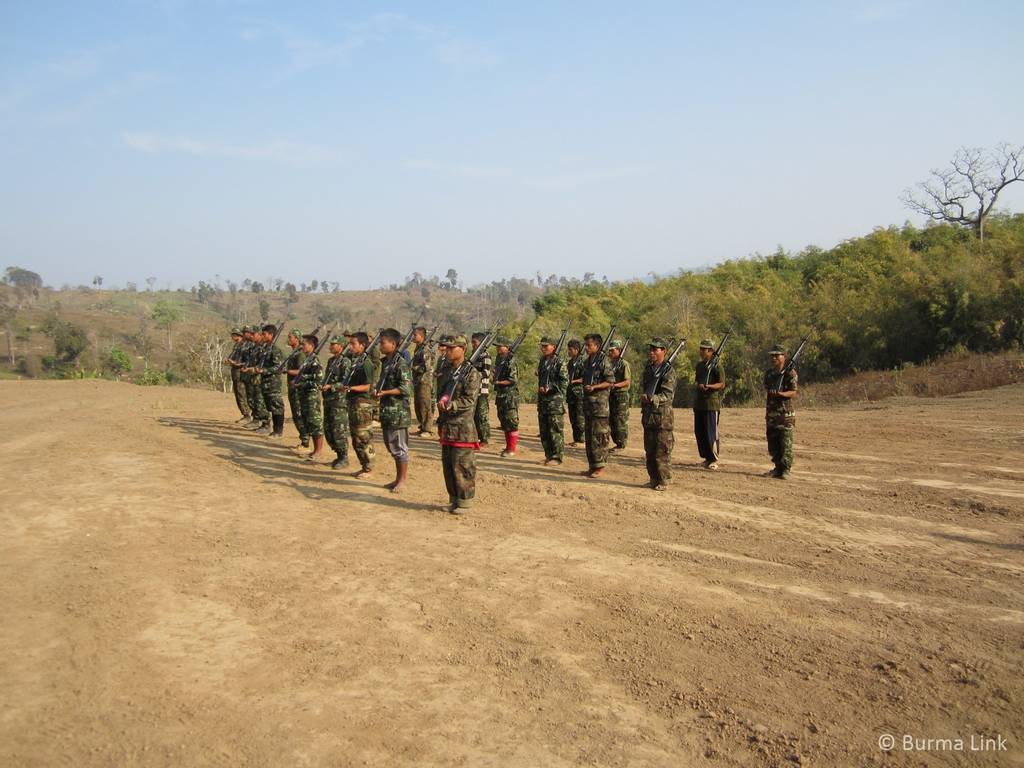
Karen National Liberation Army (KNLA) soldiers preparing for the Revolution Day parade. KNLA, the armed wing of KNU took up arms against the Burma army on January 31, 1949, celebrated as the Revolution Day ever since. (Photo: Burma Link)
By the end of the 1950s the Burmese government was once again losing control over vast territories. The Panglong agreement served as a major source of tension between the Burmese government and ethnic nationality groups. The 10-year period had ended after the Panglong agreement was signed, and ethnic leaders began realising that this pledge would not be honoured. Many ethnic leaders felt cheated by the Burman majority and tensions quickly began to rise. Several groups, including the Kachin, started armed struggles at the end of the 1950s or in the beginning of the 1960s. The largest opposition groups at this time were the KNU, New Mon State Party (NMSP), Shan State Army (SSA), and Kachin Independence Organisation (KIO).
The situation went from bad to worse after Ne Win took over the government in a military coup in 1962, established an authoritarian regime, and began a massive counter-insurgency campaign in rural areas of Burma.
In 1963, the Burmese military started using the so called ‘Four Cuts’ strategy, intended to suppress support from ethnic communities for ethnic opposition armies by cutting off the four main links between them; food, funds, intelligence and recruits (see e.g. ND-Burma, 2012a; Smith, 1994). The Four Cuts policy operated by terrorising the civilian populations in zones where ethnic nationality armies operate. It was first introduced against the KNU and other armed opposition groups in Lower Burma, before being targeted against opposition armies in the borderlands of eastern Burma (KHRG, 2010). This abuse was designed to instil fear in the civilian population in an attempt to prevent the possibility that civilian communities would provide any kind of support to the armed groups (ND-Burma, 2012a).
In order to cut support from rural villagers to ethnic armies, the Burmese military began relocating, attacking and destroying villages, as well as killing and/or torturing everyone suspected of aiding the opposition groups. Large areas became ‘free-fire’ zones (contested areas also called ‘brown’ zones), and entire communities were forced to move to fenced areas subjected to tight military control. Anyone trying to remain in their homes was shot on sight. There were also many reports of the Burmese military routinely torturing and raping civilians suspected of supporting the ethnic armies (e.g. Burma Campaign UK, April, 2011). The Four Cuts policy led to thousands of civilian deaths and the destruction of food, crops, and numerous villages (BPHWT, 2006). Tens of thousands of communities were destroyed by Four Cuts operations. In the face of international criticism, the military government began to deny the existence of the Four Cuts policy in the late 1980s (Human Rights Watch & KHRG, 2011). Nevertheless, there are claims that the policy has been practiced fairly recently (see Human Rights Watch, 2012a; Human Rights Watch & KHRG, 2011).
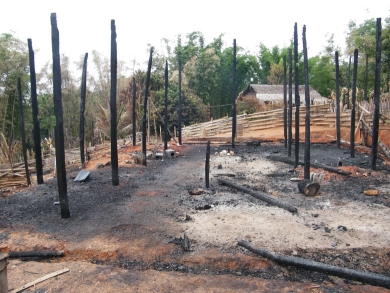
Tha Dah Der village in the Karen State after the Burma Army burnt down homes and other buildings in an attack that took place in July, 2010. (Photo: KHRG)
In 1974, Ne Win enacted a new Constitution that once again gave little autonomy to ethnic nationalities, instead further marginalising them (see Smith, 2002). Since 1976, the myriad ethnic groups that have taken up arms to fight the Burmese government have been united in the National Democratic Front (NDF).
From the 1950s to the 1980s, Burma was subject to a complex and shifting network of armed ethnic groups. In 1989 the SLORC (State Law and Order Restoration Council, as the regime was known from 1988 to 1997, see History Since Colonisation) began offering selective ceasefires to a number of other ethnic armies while simultaneously sending over 80,000 troops into action against KNU and various Mon, Kachin and Karenni armed groups. During the same period, over 200,000 Muslims from Arakan State fled violence into neighbouring Bangladesh.
The period 1988-1992 witnessed some of the heaviest fighting in Burma since independence. When the CPB disbanded in 1989 due to ethnic mutinies, four new ethnic armed groups were created, among them Burma’s largest non-state army the United Wa State Army (UWSA). Following the scam election in 1990, the National Coalition Government of the Union of Burma (NCGUB), the government in exile, was formed on December 18, 1990. The NCGUB comprised of cabinet members from various ethnic parties and organisations and aimed to abolish the military rule and to establish peace, democracy, and a genuine Federal Union.
Throughout the 1990s many ethnic armed groups could no longer withstand the intensified attacks of the Burmese military, which entered into ceasefire agreements with 17 ethnic armed groups in the 1990s (DLA Piper Rudnick Gray Cary, 2005). Some ceasefires subsequently broke down, while others prompted new armed groups to form. While ceasefire agreements brought an end to fighting in some areas of Burma, they also resulted in increased militarisation and declining socio-economic conditions for many ethnic nationalities (FIDH, ALTSEAN-Burma, & BLC, 2009). Sometimes they even resulted in more human rights violations in the ceasefire areas (see Patterns of state abuse). Importantly, these ceasefires were not peace treaties and did not result in political settlements that addressed the root causes of the armed conflict. These underlying root causes and political goals of ethnic nationalities remain unaddressed to this day.
Ethnic leaders were often lured into signing agreements based on economic privileges and economic benefits. In most cases, ceasefire groups were allowed to retain their arms and granted de facto autonomy, sometimes even control of extensive blocks of territory, and the right to extract natural resources in their territories. Human Rights Watch (2007) has argued that many of these groups have become primarily money-making armies using their arms to protect their business interests and extort resources from local populations. These economic developments have also at times been problematic on their own. As an example, when the UWSA agreed to a ceasefire with the Burmese military shortly after its formation in 1989, the Burmese military permitted UWSA to develop opium and heroin trade in Burma’s northern territories. As a result, opium and heroin production in Burma increased dramatically, doubling between 1986 and 1996. The UWSA became the most heavily-armed drug trafficking organisation in Southeast Asia (Lintner, 1999). Although opium production decreased significantly in Burma from 1999 to 2006, illicit opium cultivation has since increased every year, especially in the Kachin and Shan States where Wa special regions are also located (UNODC, 2013).
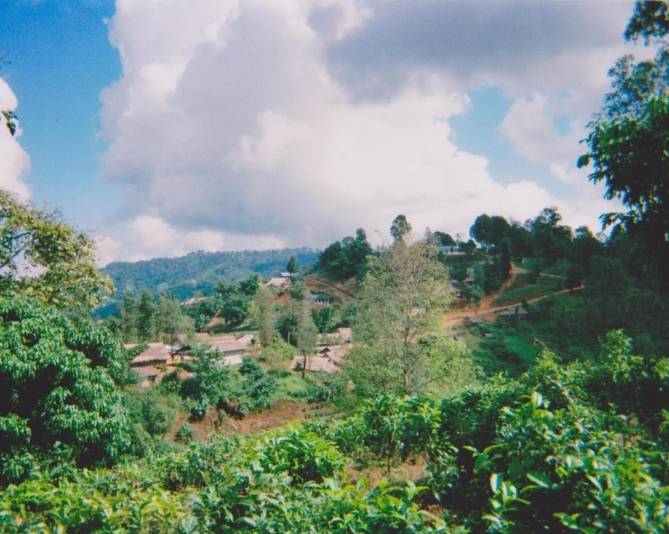
Shan State Army-South (SSA-S) military base camp in Loi Kaw Wan, Shan State, Burma. (Photo: Sai Kwan)
In the 1990s, the military government also signed an agreement with several groups allied with the KNU, such as the KIO in 1994 and the NMSP in 1995. Many ethnic nationality groups have, however, maintained active resistance against the government for decades. The main groups still fighting the Burma Army before the most recent round of ceasefires in 2011 and 2012 included the KNLA, CNF, Shan State Army-South (SSA-S), Karenni National Progressive Party (KNPP), and the Karenni Army (KA). Most of these groups gave up the objective of independence after 1988 and have instead been pursuing the objective of a democratic Federal Union (see Human Rights Watch, 2007).
In 2001, the NDF and the United Nationalities League for Democracy – Liberated Area (UNLD-LA) co-founded the Ethnic Nationalities Solidarity and Cooperation Committee (ENSCC), more recently known as the Ethnic Nationalities Council (ENC). ENC fosters unity and cooperation between all ethnic nationalities in preparation for a ‘Tripartite Dialogue” and a transition to democracy (see Ethnic Nationalities Council).
Since the late 1990s, the Burmese army battalions in the field have been required to be more or less self-sufficient, and local military units have been required to follow a policy known as ‘living off the land’ in order to sustain themselves (see e.g. KHRG, 2008; South, 2011). This policy is a corollary of the Four Cuts policy, and a crucial factor in understanding Burmese military tactics. The Burmese government as well as the military has a strong tendency to concentrate wealth, power and resources at the highest levels of authority. Accordingly, the Burmese military has left its field personnel under-resourced and forced to use civilians as a base of support: Army units in many ethnic areas depend on their continued operations and very sustenance on exploiting local villagers for labour, rice, money and other basic supplies.
Widespread forced relocations of communities in Burma have thus not only been the consequence of the Four Cuts policy but also the ‘living off the land’ policy; by forcibly relocating villages into military-controlled population centres, the army units have had a ready pool of exploitable labour, land to grow crops, people to tax, and other supplies that are required to sustain the army. This policy has exacerbated the conflict and led to widespread displacement across much of rural ethnic areas of Burma. In an attempt to avoid such relocations, thousands of civilians have chosen to either live internally displaced hiding in the jungle or flee to refugee camps in Thailand (South, 2011).
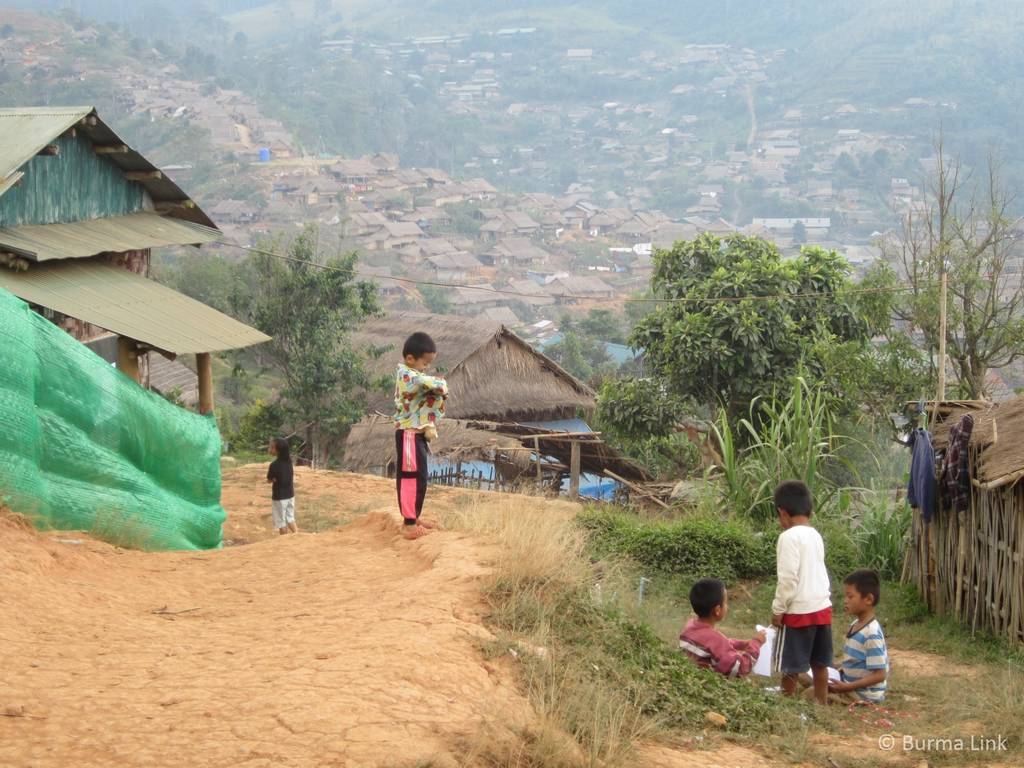
Children playing in Umpiem Mai refugee camp on the Thailand-Burma border, which is home to about 13,000 refugees from Burma. (Photo: Burma Link)
Ceasefires in Burma have often been fragile and unreliable. In December 2003, although the KNU agreed to an informal ceasefire with the Burmese government, the Burma Army continued to carry out military offensives against Karen civilians:
“There are many IDPs in Karen State, especially since the Gentlemen’s Agreement in 2003…Since the ceasefire talks, the SPDC can go anywhere they like, because they know no one will attack: This means they can just move on to where ever they like. This brings with it the looting of rice and farms and makes it hard to even feed people. The people are facing more difficulties now because the KNLA will not fight back”. (Naw Iris, a central member at CIDKP; Thanakha Team, 2005, pp. 96-97)
In May 2008, only a few days after cyclone Nargis had struck and caused widespread devastation in Burma, the military government held a referendum vote on adoption of a new Constitution. The referendum passed, though the vote was widely criticised (ALTSEAN-Burma, 2008; Laden, 2012). The 2008 Constitution once again not only failed to guarantee any ethnic nationality rights (ATSEAN-Burma, 2010), but it also underlined the role of the military regime in participating in political leadership and solidified impunity for government officials, even those suspected of committing serious human rights violations (article 445; Constitution of the Republic of the Union of Myanmar, 2008).
In accordance with the new Constitution, the government proposed that the remaining non-state armed ceasefire groups transform themselves into Border Guard Forces (BGF). These formations would entail disarming the groups and re-supplying them with government-issued weapons, and placing them under direct Burmese army commander control. Several of the less militarily powerful ceasefire groups, among them the New Democratic Army – Kachin (NDAK) and the Pa-O National Organization (PNO), accepted the transformation into BGF formations. These were mainly groups that only enjoyed limited territorial autonomy. Most of the larger and more powerful groups resisted, including the KNU, UWSA, KIO, NMSP and a breakaway Democratic Karen Buddhist Army (DKBA) faction (Kramer, 2009).
Following the government’s BGF demands, many longstanding ceasefire agreements unravelled and fighting between the government forces and ethnic armed groups spread during 2011. Conflicts broke out in Karen, Kachin, Shan, and Mon states (US State Department, 2012). In the Karen State, most DKBA soldiers refused to complete their transformation into Burmese-army-controlled BGF units and ended their 16-year ceasefire. Intensified fighting along the Thailand-Burma border forced an estimated 20,000 refugees into Thailand (Human Rights Watch, 2012a). In the Shan State, the Burmese army attacked the Shan State Army-North (SSA-N), ending a ceasefire reached in 1989. Fighting in northern Shan State displaced an estimated 30,000 civilians (Human Rights Watch, 2012a).
In the Kachin State, fighting broke out between the KIA and the Burma Army in June 2011, breaking a ceasefire signed in 1994 (Human Rights Watch, 2012a). Post-outbreak, cases of rape and other forms of torture by the Burmese army against civilians have been widely documented in the Kachin State (e.g. Human Rights Watch, 2012c; Fortify Rights, 2014a). KWAT (2012a, 2012b) estimated in May 2012 that 70,000 people in the Kachin State had been internally displaced since the conflict began, with several thousand also seeking refuge in China. More recent estimates suggest that over 100,000 have been displaced (Fortify Rights, 2014a). Although President Thein Sein had ordered the army to halt attacks in Kachin State on December 10, 2011 (Mizzima, December, 2011) as well as January 13, 2012 (see KWAT, 2012b), these directives did not result in an end to hostilities. The government and the KIA have held several peace talks in China, Thailand, and Burma, but armed conflict and human rights abuses continue to date.
Both the Burmese authorities and the KIA have acknowledged that large-scale investments in the state also form part of the backdrop to the current conflict (Human Rights Watch, 2012c, p. 29). Along with other destructive development projects, large hydropower dams are planned across Burma’s ethnic conflict areas, where they not only threaten the lives and livelihoods of millions of ethnic people, but also function as spearheads of Burma Army expansion into contested areas, fuelling conflicts and causing further displacement.
The largest projects in northern Burma in terms of capital inputs and expected earnings are a number of hydropower dams and oil and gas pipelines in Kachin State and northern Shan State (Human Rights Watch, 2012c). According to a 2012 Human Rights Watch report (2012a), there has been a reinstitution of the Four Cuts policy in Kachin, Shan and Karen States. The conflict in Kachin State escalated further in December 2012 and January 2013 when government forces began employing airstrikes that devastated many villages in the Kachin State (e.g. FBR, 2012, 2013b). A recent Kachin report also exposes how anti-insurgency strategies of the Burma Army are fuelling the drug crisis in Kachin areas (KWAT, 2014a).
Shortly after the November 2010 election, the Burmese government also began to negotiate new ceasefires with various ethnic resistance movements. The government has now reached initial agreements with groups such as the SSA, CNF, KNU, and KNPP. In February 2011, twelve ethnic armies joined together to form an umbrella organisation of ethnic parties, the United Nationalities Federal Council (UNFC), aiming to ensure that any state-level talks would be held through a common framework (Keenan, May, 2012). All NDF member organisations, except for Arakan Liberation Front (ALP), joined the UNFC. The UNFC aims to reform the new constitution and establish a genuine Federal Union of Burma, as well as a Federal Union Army to protect the people of Burma.
Although the Burmese government has recently reached preliminary ceasefire agreements with some notable armed ethnic groups, the actions taken by the Burmese army still clearly call into question the government’s commitment to peace. Furthermore, there are concerns over the sustainability of the ceasefires so long as fighting continues and human rights abuses committed against ethnic nationalities remain unaddressed. On February 8, 2012, Nai Htaw Mon, the chairman of the NMSP said that the group would not sign a ceasefire with the Burmese government as long as the war against the Kachin continues (Lawi Weng, February, 2012). On the same day, the SSA warned that its recent peace agreement with the government would be meaningless “if
Fighting has broken out between SSA and government troops a number of times since the ceasefire was signed. The Restoration Council of Shan State/Shan State Army (RCSS/SSA) reported over 30 violations of their ceasefire agreement by the Burmese military during 2012, with skirmishes continuing into 2013 (see TBC, 2013, p. 14). In April 2013, clashes between Burma army and SSA caused about 1000 locals to flee their villages in northern Shan State (Shan Herald, April, 2013), and in May, Burma Army reportedly launched an attack against Shan bases on the China-Burma border, resulting in over 800 local people fleeing across the border to China (KP, May, 2013). Increased militarisation and large-scale attacks by the Burma Army have continued in 2014, as reported by the Shan Human Rights Foundation (see e.g. SHRF statements in March, June, and July, 2014).
Continuing battles in northern and central Shan State and Kachin State have also raged between Burmese military and KIA and Ta’ang National Liberation Army (TNLA) (KLN, May, 2013; Lawi Weng, July, 2014).
These clashes have been accompanied by grave human rights violations also in ceasefire areas, particularly in northern Shan State where local organisations such as Shan Human Rights Foundation (SHRF), Palaung Women’s Organisation (PWO) and Ta’ang Student and Youth Organisation (TSYO) have reported cases of rape, killing, portering and other forced labour, arbitrary arrest and torture as well as looting and destroying property (see SHRF, April, 2013, December, 2013, March, 2014, June, 2014; PWO & TSYO, May, 2013, respectively).
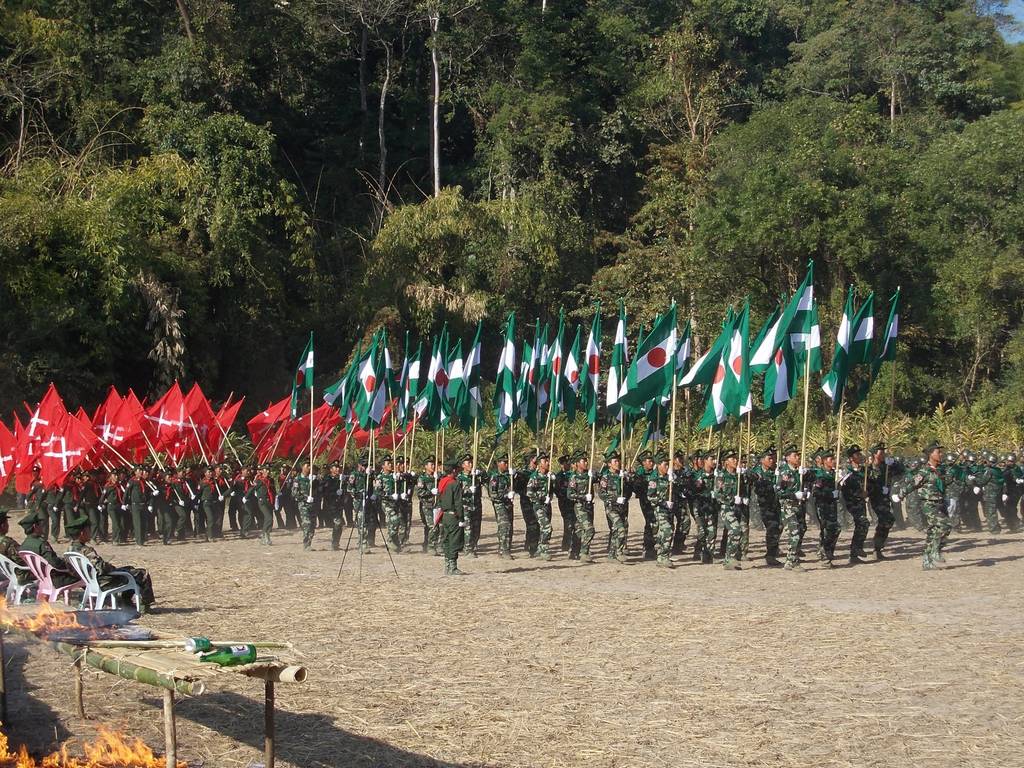
Ta’ang National Liberation Army (TNLA) and Palaung State Liberation Front (PSLF) marching in celebration of Ta’ang National Resistance Golden Jubilee January 18, 2013. (Photo: PSLF)
While a preliminary ceasefire agreement was also reached between the KNU and the government in January 2012, a union-level ceasefire is yet to be signed. Furthermore, attacks continued after the ceasefire was signed (see FIDH, ALTSEAN-Burma, FORUM-ASIA, & FDB, 2012, pp. 3-4): Less than two weeks after the initial peace agreement, two Burmese military battalions reportedly fired mortars into one of the Karen IDP camps in eastern Pegu Region. DKBA and Burma army also engaged in deadly battles near DKBA’s headquarters in Myaing Gyi Ngu, where villagers had to flee from the village for the first time since they settled there in 1995 when the DKBA was formed (see Saw Khar Su Nyar, April, 2013). In 2014, tensions have begun rising again between the Karen and the Burmese, with many clashes reported in September (see e.g. Saw Yan Naing, September, 2014). Ceasefires in Burma remain extremely fragile and unpredictable.
Meanwhile, fighting and grave human rights violations continue in the Kachin State where Burma Army continues to attack KIA and abuse villagers despite peace negotiations (see e.g. KWAT, October 2013). From October 30 to November 2, 2013, ethnic armed organisations held a conference discussing the question of the nationwide ceasefire accord, and laid down an 11-point common position on the nationwide ceasefire accord termed ‘Laiza Agreement’. An 11-member Nationwide Ceasefire Coordination Team (NCCT) was also formed in the conference (see Burma Link, November, 2013).
The geographical divide of different ethnic nationalities in Burma has been a central factor in the formation of ethnicity-based non-state armed groups, each based in their home region and drawing support from their local communities. There are several dozen non-state armed groups in Burma, and new groups are regularly created. Some groups split off from existing armies, breaking away in order to negotiate a ceasefire with the Burmese military, or breaking away from ceasefire groups in order to resume fighting. Other non-state armed groups are newly created. The size of these groups varies widely and exact numbers are difficult to establish because some groups greatly exaggerate their size, while others keep their numbers a secret. The UWSA in the Shan State is widely believed to be the largest non-state armed group, with estimated troop strength of 20,000 or more (Irrawaddy, August, 2007). No other group is generally believed to field over 10,000 troops; several are likely to have between 1,000 to 5,000 troops; and many numbering under 1,000 (Human Rights Watch, 2007, p. 95). After the UWSA, the KIA and the KNU are currently thought to form the biggest non-state armed groups.
Regrettably the Burmese government has been very successful in psychological warfare and applying what many consider a policy they learned from the British: Divide and rule. Should all the ethnic nationalities genuinely unite and see through the government’s attempts at dividing them and luring them away from their original goals, the government would find it very difficult to oppress ethnic people and steal away their natural resources. In an interview survey conducted in 2009, members of all main ethnic groups, including the majority Burman, felt that the government promotes division amongst ethnic groups in an attempt to prevent a unified opposition movement (Centre for Peace and Conflict Studies, 2010). The increasing realisation of the government tactics and psychological warfare might help the ethnic opposition to unite towards a common goal.
Since the 2010 elections, sources from various ethnic groups have reported incidents of killings, torture, abductions, and forced labour of civilians; the use of civilians as human shields and mine sweepers; and rape as a war tactic in Shan, Kachin, and Karen states (see Human rights reports). Although the Burmese government ended its call for armed resistance groups to transform into BGF in October 2011, fighting continues in eastern and northern Burma. The Burmese government has been the primary driver of violence against civilians in Burma, and most of Burma’s IDPs and refugees belong to ethnic nationality groups.
Nevertheless, there is an unprecedented climate of hope in the air for the ethnic people of Burma. After the November 2010 elections, the new nominally civilian government has surprised everyone by initiating a series of political and economic reforms. NCGUB, the government in exile, was disbanded on September 14, 2012, in order to aid national reconciliation and promote the reform process in the country (Mizzima, September 2012c). While the reforms are welcomed and encouraged, significant concerns remain; human rights abuses continue with impunity, ceasefires remain fragile and uncertain, and the military still holds absolute power in the government, albeit dressed in new civilian clothing. Many question the intentions of the government, suggesting that the military is embarking on reform “only for their own long-term survival” (Maung Zarni, November, 2012). Daw Aung San Suu Kyi and ethnic leaders have called for a second Panglong Conference where all major ethnic groups could engage openly to eventually reach a negotiated agreement in order to establish a federal system based on equality and democracy (Ko Htwe, November, 2012; Mizzima, September, 2012; NCUB, 2012a). According to Daw Aung San Suu Kyi, “a second Panglong Conference addressing the concerns of the 21st century is needed for national reconciliation” (Daw Aung San Suu Kyi, a press conference on November 14, 2010, one day after she was released from house arrest; as cited in A biography of Aung San Suu Kyi).
Until the government makes an effort to participate in a genuine dialogue with ethnic leaders to discuss a just and fair foundation for a Federal Union based on human rights and principals of justice and equality, there will be no lasting peace for the people of Burma.
Updated October 10, 2014
Continue to Burmanisation and Discrimination- For more detailed information on conflict and HRVs in specific areas in eastern Burma (Shan, Karenni, Karen, and Mon states as well as Tenasserim and Pegu division);
TBC (2008). Internal Displacement and International Law in Eastern Burma. The Border Consortium. www.tbbc.org/idps/report-2008-idp-english.pdf. Accessed August 10, 2012.
- For more information on different non-state armed groups;
Human Rights Watch (2007). Sold to be Soldiers. The Recruitment and Use of Child Soldiers in Burma (pp. 97-116).Human Rights Watch report, October 2007. www.hrw.org/reports/2007/burma1007/burma1007webwcover.pdf. Accessed August 5, 2012. © 2007 by Human Rights Watch
- For an overview of ceasefires and associated social and political issues;
Kramer, T. (2009). Neither War nor Peace: the future of the ceasefire agreements in Burma. Amsterdam: Transnational Institute.
- For an overview of the conflict and casualties on Kachin and Burmese army sides;
Blythe, S. & Hkawn Nu (2012). A thorn in Myanmar’s side. Jane’s Terrorism and Security Monitor, January 30, 2012.
Centre for Peace and Conflict Studies (2010). Listening to Voices from Inside: Ethnic People Speak.
Charney, M. W. (2009). A History of Modern Burma. Cambridge: Cambridge University Press.
Fink, C. (2001). Living Silence: Burma Under Military Rule. London: Zen Books Ltd.
Kramer, T. (2009). Neither War nor Peace: the future of the ceasefire agreements in Burma. Amsterdam: Transnational Institute.
Lintner, B. (1999). Burma in Revolt: Opium and Insurgency since 1948. Chiang Mai: Silkworm Books.
Silverstein, J. (1980). Burmese Politics and the Dilemma of National Unity. New Jersey:Rutgers University Press.
Smith, M. (1991). Burma: Insurgency and Politics of Ethnicity. London: Zed Books Ltd.
South, A. (2011). Burma’s Longest Running War: Anatomy of the Karen Conflict. Transnational Institute (TNI) & Burma Center Netherlands (BCN).

